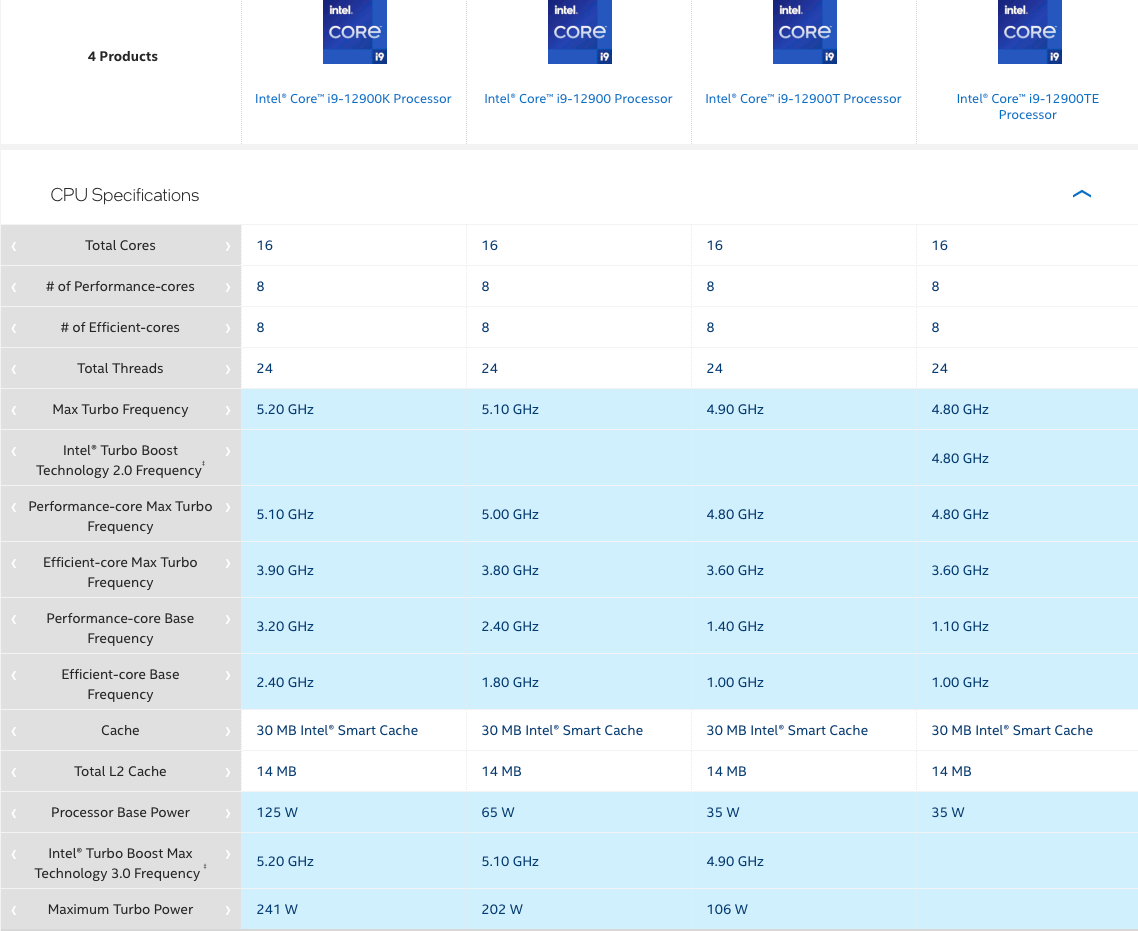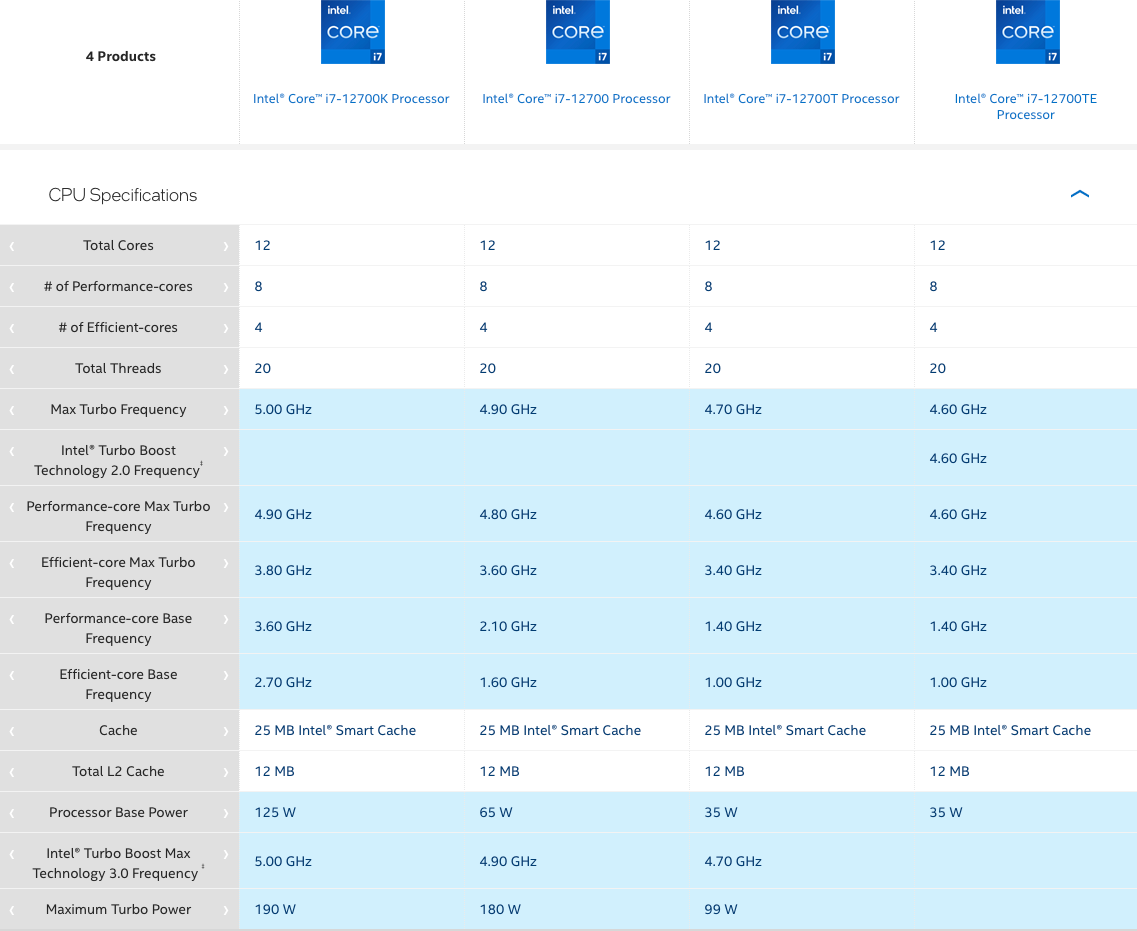Intel's 35W 'Alder Lake' T-Series CPUs Sneak into Retail
Only in Europe and Japan for now.
Intel is now shipping its latest low-power Core i7-12700T and Core i9-12900T processors with a 35W TDP in Europe and Japan, meaning we'll see them on Western shores soon. Aimed at small form-factor and fanless PCs, Intel's hybrid Alder Lake-S CPUs look particularly good for these market segments with their energy-efficient cores. They also appear to have quite reasonable pricing, too.
Beefy Configs at Low Power and Decent Pricing
Since Intel's 35W Core i9-12900T and Core i7-12700T processors are just arriving to the market, some retailers in some countries tend to charge a premium for their reduced TDP. But if you are lucky, you can buy them for a fair price at Geizhals.
In Europe, numerous retailers offer Intel's Core i9-12900T for €514 – €528 ($494 – $503 w/o tax), whereas Intel's Core i7-12700T can be purchased for €365 – €470 ($351 – $437 w/o tax) depending on the retailer and the country where you buy. Evidently, there are retailers that sell the new low-power Alder Lakes CPU without overcharging, but there are also those who want to earn a small premium.
The situation is quite different in Japan. 1-s.jp retailer (via @momomo_us) charges ¥69,980 ($552 w/o tax) for the Core i9-12900T, which is only a tad lower when compared to the $579 that Amazon charges for the Core i9-12900K in the U.S.
Now, if you feel that higher-end low-power Alder Lake parts are too expensive, European retailers actually have the whole range of Intel's 12th Generation Core T-series processors with a 35W TDP, including the Core i5-12600T, Core i5-12500T, Core i5-12400T, and Core i3-12300T that are available for €147 – €299 ($141 – $278) depending on the model, the retailer, and the country.
Intel's high-end low-power T-series processors pack all the cores and features their counterparts with higher TDPs do, but they work at considerably lower clocks to cap their base power at 35W. Intel's Core i9-12900T and Core i7-12700T processors based on the hybrid Alder Lake design are not an exception: the higher-end 12900T part comes with eight high-performance Golden Cove P-cores as well as energy-efficient Gracemont E-cores, and thus can process up to 24 threads simultaneously. The 12700T model features eight P-cores and four E-cores, and therefore can process up to 20 threads simultaneously.
Both CPUs clock their performance cores at 1.40 GHz base frequency and their efficient cores at 1.0 GHz base frequency, which is considerably lower when compared to regular non-K models with a 65W TDP.
The good news is that T-series CPUs fully support Intel's Turbo frequencies, so when cooling allows, they can push their clocks to values comparable to those of regular CPUs, and therefore offer similar performance. Of course, this will increase their Turbo power to 99W – 106W, but that is the price of additional oomph.
Meanwhile, for embedded (or not so embedded) applications that must maintain CPU TDP at 35W, Intel offers TE-series CPUs that have even lower base clocks, but the same Turbo clocks. Unfortunately, TE-series Alder Lake chips are listed on Intel's online database but aren't available at retail yet.
Surprisingly Early
Traditionally, Intel rolls out its latest CPU families from K-series unlocked halo products with an up to 125W TDP aimed at enthusiasts and gamers who demand maximum performance. Then, the company starts to sell regular non-K parts with a 65W TDP aimed at higher-end and mainstream PCs. Usually, Intel's T-series 35W processors come considerably later — two or three months after their formal launch.
This time around, while Intel's regular 12th Generation Core non-K CPUs are rather rare in the U.S., T-series 35W Alder Lake processors are readily available in Europe and we have all the reasons to believe that they will soon hit American retailers too.
Get Tom's Hardware's best news and in-depth reviews, straight to your inbox.

Anton Shilov is a contributing writer at Tom’s Hardware. Over the past couple of decades, he has covered everything from CPUs and GPUs to supercomputers and from modern process technologies and latest fab tools to high-tech industry trends.
-
King_V This has always somewhat been an unclear point for me. Intel and AMD both offer lower-power versions of their standard processors, for the desktop.Reply
Typically, the base clock rate is significantly lower, and the boost clock rate is either the same as the standard CPU, or only slightly lower.
But, speaking for both companies' CPUs, if they're going to boost like that, won't that simply mean they're not staying in their power draw rating?
And if they still do manage to stay in their power range, are they really boosting as high as claimed? And, what's the net effect on performance compared to the equivalent CPU with equivalent clocks that are not the power powered version? (T or TE for Intel, E for AMD) -
spongiemaster Reply
Base clock is for all cores. Boost clocks are typically for fewer cores. At 35W, a single Alder Lake P core should be able to boost around 5Ghz forever and stay within that power limit.King_V said:This has always somewhat been an unclear point for me. Intel and AMD both offer lower-power versions of their standard processors, for the desktop.
Typically, the base clock rate is significantly lower, and the boost clock rate is either the same as the standard CPU, or only slightly lower.
But, speaking for both companies' CPUs, if they're going to boost like that, won't that simply mean they're not staying in their power draw rating?
And if they still do manage to stay in their power range, are they really boosting as high as claimed? And, what's the net effect on performance compared to the equivalent CPU with equivalent clocks that are not the power powered version? (T or TE for Intel, E for AMD) -
jp7189 Reply
The lower tdp parts hit similar performance but for very short periods. Maybe long enough to get through an application launch before returning to steady state. Therefore they feel snappy for a user interface, but aren't meant for fulltime, high powered crunching of the big boys.King_V said:This has always somewhat been an unclear point for me. Intel and AMD both offer lower-power versions of their standard processors, for the desktop.
Typically, the base clock rate is significantly lower, and the boost clock rate is either the same as the standard CPU, or only slightly lower.
But, speaking for both companies' CPUs, if they're going to boost like that, won't that simply mean they're not staying in their power draw rating?
And if they still do manage to stay in their power range, are they really boosting as high as claimed? And, what's the net effect on performance compared to the equivalent CPU with equivalent clocks that are not the power powered version? (T or TE for Intel, E for AMD)

